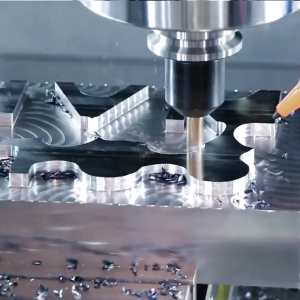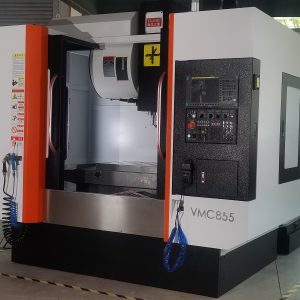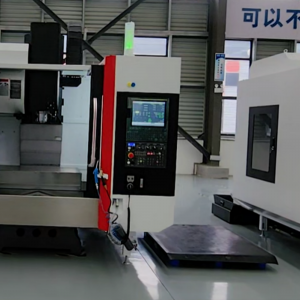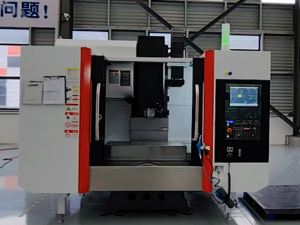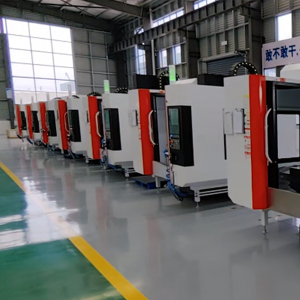In today’s manufacturing industry, CNC milling machines have been widely used due to their significant advantages such as high precision, high efficiency, and high degree of automation. However, in order to fully utilize the performance of CNC milling machines and achieve high-quality and efficient processing, the selection of cutting tools is crucial. As a key component directly involved in cutting, the reasonable selection of cutting tools will directly affect the quality and production efficiency of the final product. Based on this, this article will delve into the relevant points of tool selection in CNC milling machines.
1、 Requirements for cutting tools in CNC milling machine processing
Due to its high precision, high speed, and high degree of automation, CNC milling machines have put forward stricter requirements for the tools used. In order to ensure machining quality and improve production efficiency, CNC milling machine tools should have the following characteristics:
(1) Reliability and Durability
Firstly, cutting tools should have high reliability and durability. In the continuous machining process of CNC milling machines, the tool needs to withstand high-strength cutting forces and thermal loads for a long time. If the reliability of the tool is insufficient or its durability is low, it is easy to encounter problems such as premature wear and edge collapse, which not only affects the machining quality but also leads to frequent tool changes, increases production downtime, and reduces production efficiency. Therefore, selecting tool materials with good wear resistance, impact resistance, and thermal stability, as well as reasonable tool structure design, is the key to improving tool reliability and durability.
(2) Rigidity and strength
To meet the requirements of large cutting depth and rapid feed during rough machining, the tool should have good stiffness and strength. Large cutting depth and rapid feed can cause the tool to withstand enormous cutting forces. If the tool stiffness is insufficient, it is prone to deformation, which affects machining accuracy; Insufficient strength may lead to tool breakage and cause safety accidents. Therefore, in the process of tool design and manufacturing, measures such as optimizing the geometric shape of the tool and selecting high-strength materials should be taken to ensure that the tool has sufficient stiffness and strength.
(3) Chip breaking and removal performance
Good chip breaking and removal performance is an important condition for ensuring the normal operation of machine tools. In the process of CNC milling, the continuous generation and accumulation of chips. If the tool cannot effectively break and remove chips, it will cause chips to wrap around the tool or workpiece, affecting the stability of the cutting process and even damaging the tool and machine tool. In order to achieve good chip removal, the parameters of the cutting edge shape, front angle, and back angle of the tool should be carefully designed. At the same time, reasonable selection of cutting parameters and use of cutting fluid can also help improve the chip removal effect.
(4) Easy installation and adjustment
The convenience of tool installation and adjustment is of great significance for improving production efficiency and ensuring machining accuracy. In CNC milling machine processing, due to frequent tool replacement and adjustment of tool position, if the tool installation and adjustment process is complex and cumbersome, it will waste a lot of time. Therefore, cutting tools and tool holders with simple structure, reliable installation and positioning, and convenient adjustment should be selected to reduce tool replacement and adjustment time, and improve the utilization rate of the machine tool.
(5) High quality cutting tool materials
Choosing high-quality tool materials is the foundation for improving tool performance. At present, commonly used tool materials for CNC milling machines include high-speed steel, hard alloys, coated alloys, ceramics, cubic boron nitride, and diamond. Different tool materials have different performance characteristics, and suitable tool materials should be selected based on factors such as the material of the workpiece, processing technology, and cutting conditions. For example, high-speed steel cutting tools have good toughness and grindability, making them suitable for processing complex shaped parts and low-speed cutting; Hard alloy cutting tools have high hardness and good wear resistance, making them suitable for high-speed cutting and rough machining; Coated cutting tools further improve their performance by coating their surface with a wear-resistant and high-temperature resistant coating, making them suitable for various cutting conditions.
2、 Classification of CNC milling machine tools
There are various types of CNC milling machine tools, which can be classified into various types according to different classification standards. The following are common classification methods:
(1) Classified by tool structure
Integrated cutting tools
Integrated cutting tools refer to tools whose working part and shank are manufactured as a whole, such as end mills, drills, etc. The integral cutting tool has a simple structure and high strength, but it is difficult to manufacture and has a high cost. It is suitable for processing parts with simple shapes and high precision requirements.
Inlaid cutting tools
Inlaid cutting tools are tools that embed the blade or teeth onto the cutting body, such as inlaid end mills, turning tools, etc. The blades or teeth of embedded cutting tools can be made of different materials and geometric shapes to meet different processing requirements, and have good versatility and economy.
Special type of cutting tools
Special type cutting tools refer to tools designed to meet certain special processing requirements, such as forming tools, composite tools, etc. Formed cutting tools can process the surface of specific shaped parts, such as gear milling cutters, spline milling cutters, etc; Composite cutting tools can complete multiple processing steps in one cutting process, such as drilling and milling composite cutting tools, boring and milling composite cutting tools, etc.
(2) Classification by tool material
High speed steel cutting tools
High speed steel is a type of high alloy steel that contains a significant amount of alloying elements such as tungsten, chromium, and vanadium. High speed steel cutting tools have good toughness and grindability, and can withstand large impact loads. They are commonly used to process parts with complex shapes and high precision requirements, such as drills, taps, milling cutters, etc. According to different performance, high-speed steel cutting tools can be divided into general-purpose high-speed steel and high-performance high-speed steel.
Universal high-speed steel: Its hardness ranges from 62 to 69HRC, it has certain wear resistance, high strength and toughness, and the cutting speed is generally not higher than 45 to 60m/min, which is not suitable for high-speed cutting.
High performance high-speed steel: It is a steel grade with higher heat resistance and wear resistance obtained by increasing the content of carbon and vanadium on the basis of high-speed steel. High performance high-speed steel has good red hardness, and can still maintain a hardness of 60HRC at 620-660 ℃. Its durability is 2-3.5 times that of general-purpose high-speed steel. High performance high-speed steel is commonly used for processing difficult to machine materials such as high-temperature alloys and titanium alloys.
Hard alloy cutting tools
Hard alloy is made by powder metallurgy process using high hardness, high melting point metal carbides (such as tungsten carbide, titanium carbide, etc.) powder and binders (such as cobalt, nickel, etc.). Hard alloy cutting tools have the characteristics of high hardness, good wear resistance, and high heat resistance, with a cutting speed of 100-300m/min, suitable for high-speed cutting and rough machining. Hard alloy cutting tools can be classified into tungsten cobalt (YG), tungsten titanium cobalt (YT), and tungsten titanium tantalum (niobium) cobalt (YW) based on their composition and performance.
Tungsten cobalt (YG) hard alloys: YG hard alloys have a high cobalt content and good toughness, making them suitable for processing brittle materials such as cast iron and non-ferrous metals.
Tungsten titanium cobalt (YT) hard alloys: YT hard alloys have a high titanium content, good hardness and wear resistance, and are suitable for processing plastic materials such as steel.
Tungsten titanium tantalum (niobium) cobalt (YW) hard alloy: YW hard alloy combines the advantages of YG and YT hard alloys, with high hardness, wear resistance, heat resistance, and toughness, suitable for processing various materials, especially difficult to machine materials such as stainless steel and heat-resistant steel.
Coated cutting tools
Coated cutting tools are coated with a layer of wear-resistant and high-temperature resistant coating materials, such as TiC, TiN, Al2O3, etc., on the surface of hard alloy or high-speed steel cutting tools. Coated cutting tools can significantly improve the surface hardness, wear resistance, and heat resistance of cutting tools, and extend their service life. Coated cutting tools are suitable for various cutting conditions, especially high-speed cutting and dry cutting.
Ceramic cutting tools
Ceramic cutting tools are mainly composed of ceramic materials such as alumina (Al2O3) and silicon nitride (Si3N4), which are sintered at high temperatures. Ceramic cutting tools have advantages such as high hardness, good wear resistance, high heat resistance, and good chemical stability. The cutting speed can reach 500-1000m/min, making them suitable for high-speed cutting and precision machining. However, ceramic cutting tools have high brittleness and poor impact resistance. When using them, attention should be paid to avoiding impact loads.
Cubic boron nitride cutting tools
Cubic boron nitride (CBN) is an artificially synthesized superhard material with a hardness second only to diamond. Cubic boron nitride cutting tools have advantages such as high hardness, good wear resistance, high heat resistance, and good chemical stability. The cutting speed can reach 1000-2000 m/min, making them suitable for high-speed cutting and precision machining of high hardness materials such as quenched steel and chilled cast iron.
Diamond cutting tools
Diamond is the hardest substance in nature, and diamond cutting tools have extremely high hardness, wear resistance, and thermal conductivity. The cutting speed can reach 2000-5000m/min, making them suitable for high-speed cutting and precision machining of non-ferrous and non-metallic materials. However, diamond cutting tools are expensive and not suitable for processing iron-based metal materials, as diamonds undergo chemical reactions with iron at high temperatures.
3、 Selection of cutting tool materials for CNC milling machines
There are various types of tool materials used for CNC machining, each with its unique performance characteristics and applicability. When selecting tool materials, it is necessary to comprehensively consider factors such as the material of the workpiece, processing technology, cutting conditions, etc., in order to choose the most suitable tool material.
(1) Performance indicators of cutting tool materials for metal cutting
The cutting tool material for cutting metal usually needs to have a series of performance indicators, among which hardness, strength, red hardness, thermal conductivity, etc. are more important.
Hardness is the ability of tool materials to resist wear, and the higher the hardness, the more wear-resistant the tool is. Strength is the ability of tool materials to resist fracture and deformation, and high strength tools can withstand significant cutting forces. Red hardness refers to the ability of tool materials to maintain hardness at high temperatures, and tools with good red hardness are suitable for high-speed cutting. Thermal conductivity affects the heat dissipation effect of cutting tools. Tools with good thermal conductivity can quickly transfer cutting heat and reduce thermal wear of the tools.
(2) Ideal tool material
The ideal tool material should have both hardness and strength, as well as good red hardness, thermal conductivity, wear resistance, and toughness. However, in practical applications, it is difficult to find a tool material that fully meets all requirements, so it is necessary to weigh and choose according to specific processing conditions.
(3) Commonly used cutting tool materials in practical applications
In practical processing, hard alloy and coated hard alloy cutting tools are most widely used due to their excellent comprehensive performance.
Hard alloy cutting tools have high hardness and wear resistance, which can adapt to the requirements of high-speed cutting and rough machining. Coated hard alloy cutting tools, on the basis of hard alloy cutting tools, further improve their performance and extend their service life by coating them with a layer of wear-resistant and high-temperature resistant coating.
For some difficult to machine materials, such as high-temperature alloys, titanium alloys, etc., cubic boron nitride cutting tools and diamond cutting tools have unique advantages. Cubic boron nitride cutting tools have high hardness and good red hardness, which can effectively cut high hardness materials; Diamond cutting tools have extremely high hardness and thermal conductivity, making them suitable for precision machining of non-ferrous and non-metallic materials.
Although high-speed steel cutting tools are not as hard and wear-resistant as hard alloy cutting tools, they still have certain applications in processing complex shaped parts and low-speed cutting due to their good toughness and grindability.
Ceramic cutting tools have high hardness and good wear resistance, but they are brittle and suitable for high-speed cutting and precision machining.
4、 The influencing factors of tool selection for CNC milling machines
When selecting CNC milling machine tools, the following factors need to be comprehensively considered:
(1) Machine tool performance
Different types and specifications of CNC milling machines have different performance characteristics, such as spindle speed, feed rate, power, torque, etc. The selection of cutting tools should match the performance of the machine tool to fully unleash its potential. For example, for high-speed milling machines, suitable cutting tools for high-speed cutting should be selected, such as coated hard alloy tools, ceramic tools, etc; For high-power milling machines, cutting tools with higher strength and stiffness can be selected, such as integral hard alloy cutting tools.
(2) Workpiece material
The performance of workpiece materials has a significant impact on tool selection. Different workpiece materials have different hardness, strength, toughness, thermal conductivity, etc. For example, when processing brittle materials such as cast iron, YG type hard alloy cutting tools can be chosen; When processing plastic materials such as steel, it is advisable to choose YT type hard alloy cutting tools or coated cutting tools; When processing difficult to machine materials such as high-temperature alloys and titanium alloys, cubic boron nitride cutting tools or diamond cutting tools need to be selected.
(3) Processing program
The type of machining program (such as rough machining, semi precision machining, precision machining) and cutting parameters (such as cutting speed, feed rate, cutting depth) also affect the selection of cutting tools. When rough machining, cutting tools with high strength and stiffness that can withstand large cutting forces should be selected, such as solid hard alloy cutting tools; When precision machining, tools with high precision and good surface quality should be selected, such as coated hard alloy tools or ceramic tools.
(4) Cutting amount
The magnitude of the cutting amount directly determines the cutting force and cutting heat borne by the tool. When machining with large cutting amounts, cutting tools with high strength and good heat resistance should be selected; When machining with small cutting amounts, cutting tools with high hardness and good wear resistance can be selected.
5、 Steps and methods for selecting cutting tools for CNC milling machines
When selecting CNC milling machine tools, the following steps can be followed:
(1) Determine processing requirements
Firstly, it is necessary to clarify the shape, size, precision requirements, surface quality requirements, and processing techniques (such as rough machining, semi precision machining, and precision machining) of the processed parts.
(2) Analyze the material of the workpiece
Analyze the performance of the workpiece material, including hardness, strength, toughness, thermal conductivity, etc., to determine the suitable tool material.
(3) Select tool type
According to the processing requirements and workpiece materials, choose the appropriate type of tool, such as end mills, drills, boring cutters, etc.
(4) Determine tool parameters
Determine the diameter, length, number of edges, helix angle, leading angle, trailing angle, and other parameters of the cutting tool based on cutting parameters and machine performance.
(5) Choose cutting tool brands and suppliers
After determining the type and parameters of the cutting tools, choose well-known brands and reliable suppliers to ensure the quality of the tools and after-sales service.
6、 Use and maintenance of CNC milling machine tools
Choosing the appropriate tool is just the first step, and proper use and maintenance of the tool are equally crucial for ensuring machining quality and extending tool life.
(1) Installation of cutting tools
When installing the tool, it is important to ensure the accuracy of the fit between the tool and the tool holder, ensuring that the tool is firmly and accurately installed. At the same time, attention should be paid to the installation direction and position of the tools to avoid installation errors that may cause machining errors or tool damage.
(2) Selection of cutting parameters for cutting tools
Reasonable selection of cutting parameters is the key to ensuring normal cutting and extending tool life. Cutting parameters include cutting speed, feed rate, cutting depth, etc., and should be comprehensively considered based on factors such as tool material, workpiece material, and machining process. Generally speaking, within the allowable range of cutting tools, higher cutting speeds and smaller feed rates should be selected to improve machining efficiency and surface quality.
(3) Cooling and lubrication of cutting tools
During the cutting process, appropriate cooling and lubrication methods should be used to reduce cutting temperature, reduce tool wear, and improve the quality of the machined surface. Common cooling and lubrication methods include cutting fluid cooling, air cooling, oil mist lubrication, etc.
(4) Maintenance and upkeep of cutting tools
After processing, the chips and oil stains on the cutting tools should be cleaned in a timely manner, and the wear of the tools should be checked. If there is any wear, it should be sharpened or replaced in a timely manner. At the same time, regular maintenance should be carried out on the cutting tools, such as applying rust proof oil, checking the accuracy of the tool handle, etc., to ensure the performance and service life of the cutting tools.
7、 Conclusion
The selection of cutting tools for CNC milling machines is a complex and important task that requires comprehensive consideration of multiple factors such as machine performance, workpiece materials, machining programs, and cutting amounts. Choosing and using cutting tools correctly can not only improve machining quality and production efficiency, but also reduce production costs and extend the service life of machine tools. Therefore, in actual production, the most suitable tool should be selected based on the specific processing situation and the performance characteristics of the tool, and the use and maintenance management of the tool should be strengthened to fully leverage the advantages of CNC milling machines and provide strong support for the development of the manufacturing industry.

